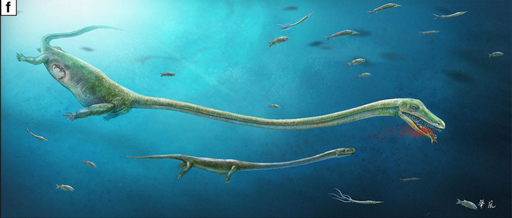
What do birds, crocodiles, and dinosaurs have in common? They’re all part of a group of animals called archosauromorpha and they typically reproduce by laying eggs.
But not so with their relative: an ancient marine reptile known as Dinocephalosaurus. The Loch Ness monster look-alike grew to a length of about 13 feet, with its long neck making up almost half of its size.
Researchers discovered the fossil of a pregnant Dinocephalosaurus from 245 million years ago with an embryo inside its abdomen, making this the first known case of an archosauromorph giving birth to live young.
According to a study published in the journal Nature Communications, the researchers determined that the baby specimen was, in fact, an embryo (and not food) because it was curled up in a fetal position with its neck pointing forward. Sea creatures usually swallow their prey head first.
And despite the fetus’s tiny size, they were also able to make out anatomical details that resembled the adult Dinocephalosaurus. They also didn’t see any evidence of a calcified eggshell on the fossil.

The researchers think the creatures might have evolved to deliver babies through live birth because their “large paddle-like limbs” and giant necks made it difficult to walk around on land and build nests, the way sea turtles do, for example. Their lifestyle was much more conducive to live birth since reptilian eggs can’t be incubated underwater.
“Our discovery pushes back evidence of reproductive biology in the clade by roughly 50 million years, and shows that there is no fundamental reason that archosauromorphs could not achieve live birth,” said the researchers in the study.




